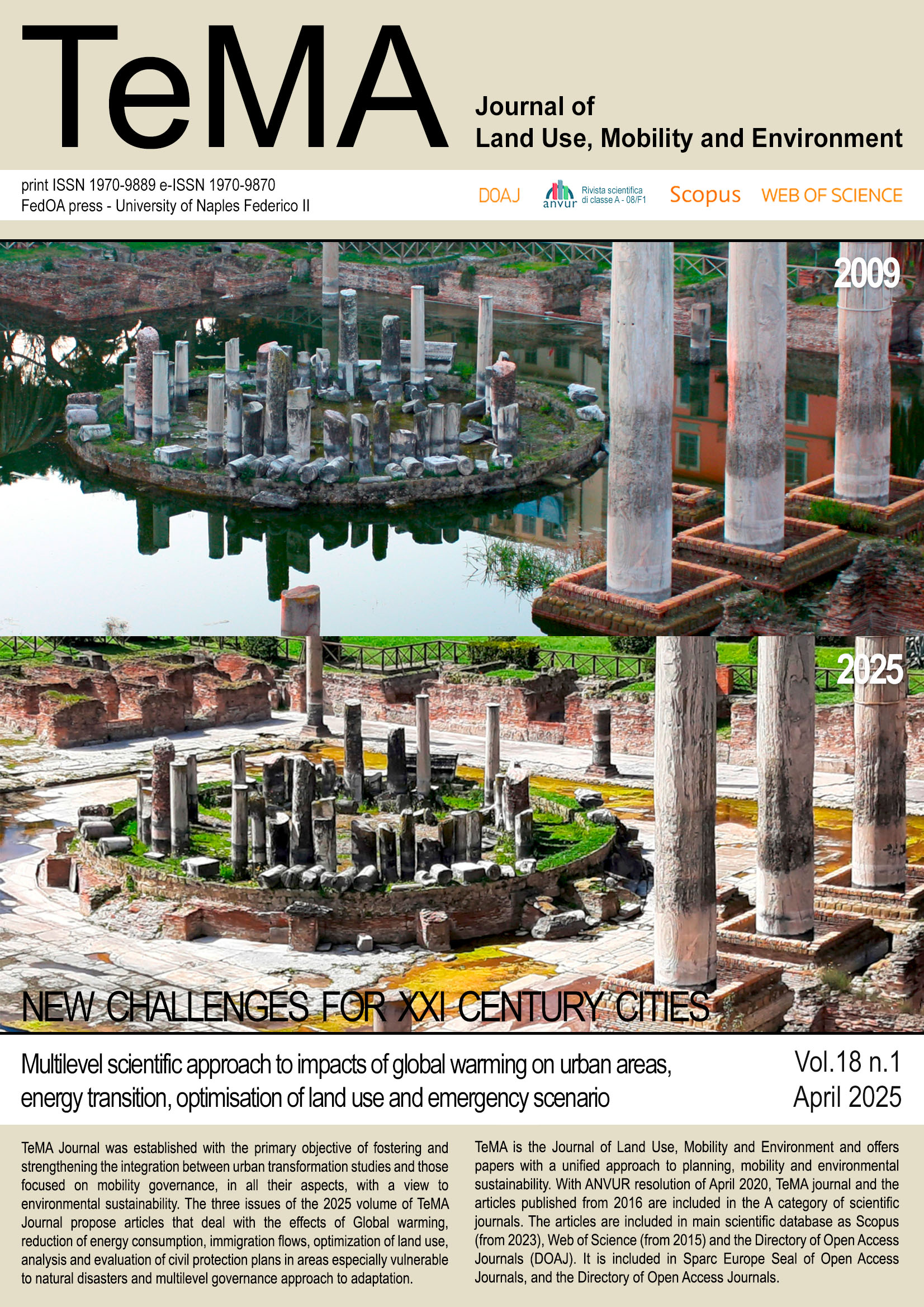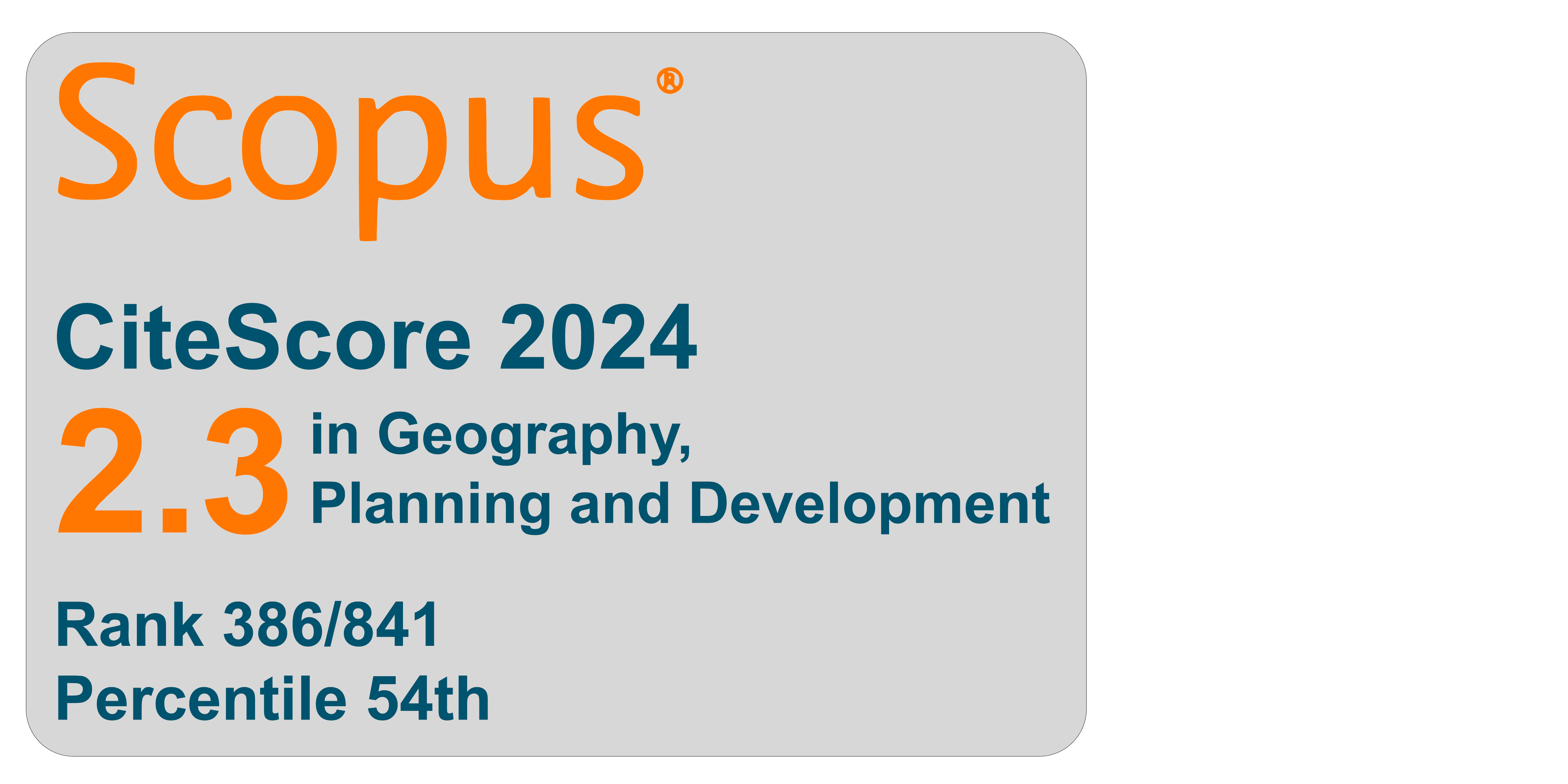Situating walkability: examining walkability elements on recurring routes
DOI:
https://doi.org/10.6093/1970-9870/10999Keywords:
Mobility, Walkability, Body-environment relations, Urban space, Urban temporalityAbstract
Walking is widely regarded as a ubiquitous, affordable, healthy and zero-carbon mobility mode that enhances the liveliness and inclusivity of urban spaces. In recent years, the concept of ‘walkability' has emerged as a central criterion for assessing the sustainability and liveability of cities. Walkability elements and metrics are often employed to map urban environments, evaluating their capacity to facilitate or hinder walking from the perspective of experts and professionals. However, how do these metrics relate to the situated subjective walker-street relations, contexts and experiences? This study employs ethnographic mobile research methods to examine the connections between walkability elements of the physical built environment and the everyday walking experiences on recurring day-to-day routes in two mid-sized cities in Finland. Utilizing walkability metrics related to visual urban design elements from research literature, the study explores the role of the elements in shaping the walking experience in the context of regularly travelled routes and the subjective body-environment relations. The study highlights that the walkability elements can act as important anchoring points in the study of the body-environment relations in the context of the habitual everyday urban mobility. The importance of ‘imageability’ and ‘complexity’ elements is discussed, as well as the role of temporality and ‘rhythm’ in the walking experience.
Downloads
References
Adkins, A., Dill, J., Luhr, G. & Neal, M. (2012). Unpacking Walkability: Testing the Influence of Urban Design Features on Perceptions of Walking Environment Attractiveness. Journal of Urban Design, 17 (4), 499-510. https://doi.org/10.1080/13574809.2012.706365
Aparicio, J. T., Arsenio, E., Santos, F. C. & Henriques, R. (2024). Walkability defined neighborhoods for sustainable cities. Cities, 149, http://dx.doi.org/10.1016/j.cities.2024.104944
Appleyard, D. (1981). Livable Streets. University of California Press.
Aronson, J. (1995). A Pragmatic View of Thematic Analysis. The Qualitative Report, 2 (1), 1-3. http://dx.doi.org/ 10.46743/2160-3715/1995.2069
Banister, D. (2008). The sustainable mobility paradigm. Transport Policy, 15 (2), 73-80. https://doi.org/10.1016/j.tranpol.2007.10.005
Beaumont, M. (2024). How We Walk: Frantz Fanon and the Politics of the Body. Verso.
Boyce, C. (2010). Walkability, Social Inclusion and Social Isolation and Street Redesign. Built Environment, 36 (4), 461-473. https://doi.org/10.2148/benv.36.4.461
Böhm, S., Jones, C., Land, C. & Paterson, M. (2006). Introduction: Impossibilities of automobility. In S. Böhm, C. Jones, C. Land & M. Paterson (Eds.), Against Automobility. Blackwell.
Cappe, L. (1987). Including Transit. In A. V. Moudon (Ed.), Public streets for public use. Van Nostrand.
Cargnin, M. J., Marino, C. de C. & Silva, T. L. da. (2024). The 15-minute cities concept applied to a Brazilian neighborhood: case study of the cidade universitária Pedra Branca neighborhood in Palhoça-SC. TeMA - Journal of Land Use, Mobility and Environment, 17 (2), 189-191. https://doi.org/10.6093/1970-9870/10314
de Certeau, M. (1990). Arkipäivän kekseliäisyys 1: Tekemisen tavat (T. Kilpeläinen, Trans.). Niin&näin. (Original work published 1980)
Cervero, R., Guerra, E. & Al, S. (2017). Beyond Mobility: Planning Cities for People and Places. Island Press.
City of Vancouver. (2012). Transportation 2040. City of Vancouver.
Coverley, M. (2022). The Art of Wandering: The Writer as Walker. Oldcastle.
Cresswell, T. (2010). Towards a politics of mobility. Environment and Planning D: Society and Space, 28 (1), 17-31. https://doi.org/10.1068/d11407
Cullen, G. (1961). Townscape. The Architectural Press.
D’Amico, A. (2024). Examples of good experiences for child-friendly cities. Comparison of sustainable practices in Italy and around the world. TeMA - Journal of Land Use, Mobility and Environment, 17 (2), 143-155. https://doi.org/10.6093/1970-9870/10886
Dovey, K. & Pafka, E. (2020). What is Walkability? The urban DMA. Urban Studies, 57 (1), 93-108. https://doi.org/10.1177/0042098018820937
Dunn, N. & Cureton, P. (2020). Future Cities: A Visual Guide. Bloomsbury.
Evans, J. & Jones, P. (2011). The walking interview: Methodology, mobility and place. Applied Geography, 31 (2), 849-858. https://doi.org/10.1016/j.apgeog.2010.09.005
Ewing, R. & Handy, S. (2009). Measuring the Unmeasurable: Urban Design Qualities Related to Walkability. Journal of Urban Design, 14 (1), 65-84. https://doi.org/10.1080/13574800802451155
Ewing, R. H. & Clemente, O. (2013). Measuring Urban Design: Metrics for Livable Places. Island Press.
Fancello, G., Congiu, T. & Tsoukiàs, A. (2020). Mapping walkability. A Subjective value theory approach. Socio-Economic Planning Sciences, 72. https://doi.org/10.1016/j.seps.2020.100923
Fernandes, J., Chamusca, P., Gasnier, A., Kärrholm, M. & Pujol, C. (2015). Time policies, urban policies and planning. Geografia e Ordenamento do Território, 7, 129-157. https://doi.org/10.17127/got/2015.7.129-157
Fonseca, F., Ribeiro, P. J., Conticelli, E., Jabbari, M., Papageorgiou, G., Tondelli, S. & Ramos, R. A. R. (2022). Built environment attributes and their influence on walkability. International Journal of Sustainable Transportation, 16 (7), 660-679. https://doi.org/10.1080/15568318.2021.1914793
Forsyth, A. (2015). What is a Walkable Place? The Walkability Debate in Urban Design. Urban Design International, 20 (4), 274-292. https://doi.org/10.1057/udi.2015.22
Foster, K. A., Davis, B. & Foell, A. (2023). Innovations to Photovoice: Using Smartphones & Social Media. Urban Affairs Review, 59 (5), 1728-1744. https://doi.org/10.1177/10780874221100263
Gehl, J. (1971). Life Between Buildings: Using Public Space (J. Koch, Trans.). Island Press. (Original work published 1971)
Greater London Authority. (2018). Mayor’s Transport Strategy. Greater London Authority.
Harper, D. (2002). Talking about pictures: a case for photo elicitation. Visual Studies, 17 (1), 13-26. https://doi.org/10.1080/14725860220137345
Ingold, T. (2004). Culture on the Ground. The World Perceived Through the Feet. Journal of Material Culture, 9 (3), 315-340. https://doi.org/10.1177/1359183504046896
Jacobs, J. (1961). The Death and Life of Great American Cities. Modern Library. (Original work published 1961)
Jensen, O. B. (2013). Staging Mobilities. Routledge.
Jiron, P. (2010). Repetition and Difference: Rhythms and Mobile Place-making in Santiago de Chile. In T. Edensor (Ed.), Geographies of Rhythm: Nature, Place, Mobilities and Bodies. Ashgate.
Jokinen, A., Asikainen, E. & Mäkinen, K. (2010). Kävelyhaastattelu tapaustutkimuksen menetelmänä. Sosiologia, 41 (3), 286-296.
Kärrholm, M. (2007). The Materiality of Territorial Production: A Conceptual Discussion of Territoriality, Materiality, and the Everyday Life of Public Spaces. Space and Culture, 10 (4), 437-453. https://doi.org/10.1177/1206331207304356
Kusenbach, M. (2003). Street phenomenology. The go-along as ethnographic research tool. Ethnography, 4 (3), 455-485. https://doi.org/10.1177/146613810343007
Lorimer, H. (2011). Walking: New Forms and Spaces for Studies of Pedestrianism. In T. Cresswell & P. Merriman (Eds.), Geographies of Mobilities: Practices, Spaces, Subjects. Ashgate.
Lynch, K. (1960). The Image of the City. MIT Press.
Lynch, K. (1972). What Time Is This Place?. MIT Press.
Middleton, J. (2011). ‘I’m on Autopilot, I Just Follow the Route’: Exploring the Habits, Routines, and Decision-Making Practices of Everyday Urban Mobilities. Environment and Planning A, 43 (12), 2857-2877. https://doi.org/10.1068/a43600
Middleton, J. (2018). The socialities of everyday urban walking and the ‘right to the city’. Urban Studies, 55 (2), 296-315. https://doi.org/10.1177/0042098016649325
Moreno, C., Allam, Z., Chabaud, D., Gall, C. & Pratlong, F. (2021). Introducing the “15-Minute City”: Sustainability, Resilience and Place Identity in Future Post-Pandemic Cities. Smart Cities, 4 (1), 93-111. https://doi.org/10.3390/smartcities4010006
Mumford, L. (1964). The Highway and the City. Harcourt, Brace & World.
Patton, J.W. (2007). A pedestrian world: competing rationalities and the calculation of transportation change. Environment and Planning A, 39 (4), 928-944.
Paydar, M. & Fard, A.K. (2021). The Hierarchy of Walking Needs and the COVID-19 Pandemic. International Journal of Environmental Research and Public Health (MDPI), 18. http://dx.doi.org/10.3390/ijerph18147461
Pink, S. (2007). Doing visual ethnography: images, media and representation in research. London: Sage.
Raisio, H. & Ehström, P. (2017). Taking Deliberation to the Streets: Reflections on Deliberative Walks. Scandinavian Journal of Public Administration, 21 (4), 27-51.
Rapoport, A. (1982). The Meaning of the Built Environment : A Nonverbal Communication Approach. London: Sage.
Roper, J., Ng, M. & Pettit, C. (2023). Incorporating diminishing returns of opportunities in access: Development of an open-source walkability index based on multi-activity accessibility. The Journal of Transport and Land Use, 16 (1), 361-387
Shashank, A. & Schuurman, N. (2019). Unpacking walkability indices and their inherent assumptions. Health & Place, 55, 145-154. http://dx.doi.org/10.1016/j.healthplace.2018.12.005
Sheller, M. & Urry, J. (2006). The new mobilities paradigm. Environment and Planning A, 38 (2), 207-226.
Southworth, M. (2005). Designing the Walkable City. Journal of Urban Planning and Development, 131 (4), 246-257. https://doi.org/10.1061/(ASCE)0733-9488(2005)131:4(246)
Speck, J. (2012). Walkable City: How Downtown Can Save America One Step at a Time. New York: Farrar, Straus and Giroux.
Stevens, Q. (2007). The Ludic City: Exploring the potential of public spaces. Routledge. https://doi.org/10.4324/9780203961803
Tartia, J. (2020). The Temporality and Rhythmicity of Lived Street Space (Doctoral dissertation, Tampere University). Retrieved from https://urn.fi/URN:ISBN:978-952-03-1387-6
Tekolla, A. W., Tarekegn, A. G. & Tulu, G. S. (2024). Measuring the walkability of areas around Addis Ababa LRT stations by integrating Analytic Hierarchal Process (AHP) and GIS. TeMA - Journal of Land Use, Mobility and Environment, 17 (3), 423-438. https://doi.org/10.6093/1970-9870/11025
Thoreau, H. D. (1862). Kävelystä (A. Immonen, Trans.). Basam Books. (Original work published 1862)
Tonkiss, F. (2013). Cities by Design: The Social Life of Urban Forms. Polity Press. https://doi.org/10.51347/jum.v19i1.4861
Türken, A. Ö. & Conticelli, E. (2024). Role of new technologies on pedestrian walking behaviour research. TeMA - Journal of Land Use, Mobility and Environment, 17 (3), 83-96. https://doi.org/10.6093/1970-9870/10929
Urry, J. (2007). Mobilities. Polity Press.
WalkScore. (2023). Walk Score. Website. Retrivred form: https://www.walkscore.com/
Werner, C. M., Brown, B. B., Stump, T., Tribby, C. P., Jensen, W., Miller, H. J., Strebel, A. & Messina, A. (2018). Street use and design: daily rhythms on four streets that differ in rated walkability. Journal of Urban Design, 23 (4), 603-619. https://doi.org/10.1080/13574808.2018.1503085
Downloads
Published
How to Cite
License
Copyright (c) 2025 TeMA - Journal of Land Use, Mobility and Environment

This work is licensed under a Creative Commons Attribution-NonCommercial 4.0 International License.



